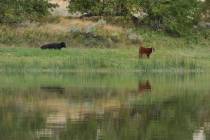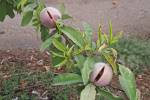Several reasons tomatoes plants won’t set fruit
Q: I have some Early Girl tomatoes that I planted in March from plantlets that I bought. I talked to the Early Girls about a month later and told them that if they did not flower in the following week, I would feed them to the worms in my compost pile. Well they seemed to have listened, because they made lots of flowers but the flowers didn’t set fruit. What did I do wrong?
A: Tomatoes are pollinated by insects, primarily bees. However, if temperatures are in the 90 s and above they have trouble setting fruit. They just don’t like those high temperatures for pollination. They set better when temperatures are in the high 60 s and 70 s up to about 85 degrees.
Other reasons for flower drop and no fruit set might be uneven watering, so it is a good idea to mulch the plants. Straw is a good choice. I think a bale of straw goes for about $8 locally.
Low night temperatures below 55 degrees can cause flower drop as well. Also over fertilizing with nitrogen fertilizer may cause no flower development until the nitrogen is depleted a bit from the soil.
If temperatures are good, the bee does not actually have to visit the flower. Vibrations from bee activity are enough to set the fruit. If tomatoes are grown in greenhouses, for instance, and there are no insects in the house, the movement of the plants from vibrations caused by an electric toothbrush is often times enough to get them to set.
So make sure you have pollinator activity when temperatures are appropriate for fruit set. Otherwise, gently shake them while you are talking to them. Maybe a slight physical threat might work.
Another thing you can do is buy some tomato fruit setting chemicals. These are synthetic copies of natural plant growth regulators called gibberellins. It is usually applied when temperatures are cool, not hot like now. They are sold in nurseries or garden centers with names such as tomato fruit set . Follow the label directions.
Q: I’ve just spotted Colorado potato beetle bugs and larvae on my tomatillo plants. I didn’t even know what they were until I did some research. I’ve never seen them out here before. I can’t find an organic pesticide that will kill them without hurting the bees and other beneficial insects. Do you have any advice for me?
A: Make sure it is actually the Colorado potato beetle and not a look-alike insect called the Ten Lined June Beetle. I have not seen the Colorado potato beetle in the Las Vegas area yet but it is possible. Until recently, Nevada was one of four states that didn’t have this pest.
But I have seen the Ten Lined June beetle here and they look very similar to the Colorado potato beetle. I posted a picture of this critter on my blog. The safest way is to pick them off as you see them. In small garden plots this works well. You can also use a cordless vacuum cleaner and suck them up that way.
As far as sprays go an organic/biological pesticide called Spinosad, which is available in many nurseries now, will give some control.
Another organic/biological control chemical is Bacillus thuringiensis (Bt) var. San Diego (also called variety tenebrionis) gives some control if they are not resistant. This particular type of Bt controls beetles. But this organic spray is hard to find locally. You will probably find it only online.
There are Bt sprays in the nurseries but this is the wrong Bt spray for Colorado potato beetle. The one in the nu rseries is Bt var. kurstaki (Btk). This Bt is used to control larvae or caterpillars that form moths and butterflies like the tomato fruit worm, tomato hornworm and grape leaf skeletonizer.
Q: I hope you can view the pictures that are attached. As you can see, one of my shoestring acacia is growing out on an angle and my fear is it will get to heavy and topple. Is there any way to save this tree by putting a support under the trunk or topping it by cutting it back? It was planted seven years ago with two others and this is the only one that is doing this. It is about 20 feet high .
A: Thanks for the pictures. Actually your tree looks nice in your setting.
There are two things I am noticing from your pictures. First to answer your question, make sure the tree is getting water at distances equal to at least half the canopy area under the tree. You can do this by adding emitters or a water source in scattered areas under the canopy.
If the only water sources are close to the trunk, the roots may stay too close to the trunk and begin falling over when it gets top heavy. By putting water f arther from the trunk it encourages a larger area of support for the tree and its growing canopy. These emitters under the canopy can be used to support other plants as well so that it is not just watering the soil for weeds to grow.
Lawns around trees also help to support tree root growth that keeps trees from toppling over. Roots do not grow “in search of water” but will grow only where there is water in the desert. Rainfall does not count in a true desert.
If the tree or shrub was purchased in a container and the roots began circling in the container (the plant was overgrown in the container), it may continue to circle once planted and never create a strong foothold in our desert soil. The roots circle and circle and never spread out like they should.
When the top gets big, these trees with circling roots tend to lean or blow over in a strong wind. They can become a liability as they get older. Unfortunately, these plants can never be rescued and must be removed to prevent loss of property or cause safety concerns.
Never buy plants in containers where the roots have grown in circles inside. They can never be established as healthy trees that are safe for public or private use.
Bob Morris is a horticulture expert living in Las Vegas and professor emeritus for the University of Nevada. Visit his blog at xtremehorticulture.blogspot.com.























